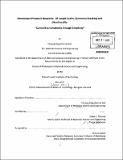Generalized phononic networks : of length scales, symmetry breaking and (non) locality : "controlling complexity through simplicity"
Author(s)
Koh, Cheong Yang (Cheong Yang Henry)
DownloadFull printable version (20.51Mb)
Alternative title
Controlling complexity through simplicity
Other Contributors
Massachusetts Institute of Technology. Dept. of Materials Science and Engineering.
Advisor
Edwin L. Thomas.
Terms of use
Metadata
Show full item recordAbstract
The manipulation and control of phonons is extremely important from both a fundamental scientific and applied technological standpoint, providing applications ranging from sound insulation to heat management. Phononic crystals and metamaterials are artificially structured materials (at certain length scales) that provide promise in controlling the propagation of phonons in solids. However, the vector nature of the phonon makes the development of a governing framework with which to guide the design of these phononic metamaterials complicated and no coherent framework exists for the design of phononic structures. In this thesis, we utilize a combination of global symmetry principles, adopted from group theory and the theory of representations, together with conservation principles and broken symmetry concepts to formulate our generalized design framework. This framework allows us to exactly treat the vector nature of phonons and control their propagation, unifying the design of phononic crystals, metamaterials, waveguides and numerous other structures, both infinite and finite. In particular, utilizing only this general framework which we develop, we are able to explain the choice of a particular physical topography for a desired phononic propagation behavior in a coherent fashion. In addition, we show how we may explicitly control the dispersion relations of a phononic metamaterial in order to obtain a desired final band structure. Some of our demonstrations include a new polychromatic phononic metamaterial which possesses multiple complete in-plane spectral gaps totaling over 100% in normalized gap size to a phononic metamaterial which exhibits a single complete in-plane spectral gap of 102% and a complete spectral gap of 88%, both significant advancements over the state of the art. This thesis also removes the artificial distinction between the phononic crystal and metamaterial classifications by unifying their behavior within the same generalized framework. As a result, we show that only a few governing principles are required to design the complex band dispersion relations of phononic metamaterials. The generality of our framework allows extension to other vector and scalar waves, such as photonic, plasmonic and magnonic structures and provides a promising route forward to the development of integrated structured material platforms that allow for the rational manipulation and interactions of phonons with other waves, such as phonons and spin waves.
Description
Thesis (Ph. D.)--Massachusetts Institute of Technology, Dept. of Materials Science and Engineering, 2011. Cataloged from PDF version of thesis. Includes bibliographical references (p. 214-217).
Date issued
2011Department
Massachusetts Institute of Technology. Department of Materials Science and EngineeringPublisher
Massachusetts Institute of Technology
Keywords
Materials Science and Engineering.